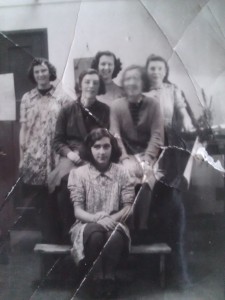Following Women’s International Day on 8 March 2014, it is appropriate that the role of women and their voices be given attention. Port Towns are ostensibly about men, masculinity and male bonds of friendship. Men have arguably shaped our understandings of port towns, their projected identity and this has left a lasting presence on the understanding of ports, port related industry and the sea. However, women also played important roles in port towns. This article seeks to address this gender imbalance by showing within the workplace despite being in an inferior position to men, women were able to make autonomous decisions and act independently within a patriarchal framework of male bosses and male ran trade unions.[1]
The focus of this article will be upon one woman, Dorothy who worked in the Tracings office at Samuel White’s Boat Builders in East Cowes on the Isle of Wight during the Second World War. Her testimony cannot be analysed as representative of all women, nor can her views be shown to embody those of women generally. However, her narrative indicated that she was aware of her unequal position in the workplace and that the union would not support her desire for more pay to support her family and transport costs to work. She said:
As the union would not support her, Dorothy decided to go to the head draughtsman Mr Scadding directly. Here she spoke to both Mr Scadding and the Managing Dircetor Mr A. A. Milne. After the discussion, the end result was their wages increased from 12 and 6 to 14 shillings a week. When asked what the other women in the Tracing’s office thought about her “revolt” Dorothy said: “Well they all wanted more [money] but some felt, you know it’s not our place to do this sort of thing and thought I was being pushy”.[3] This shows that the women were aware they were on a low rate of pay but felt it was not for them to question this. James Hinton notes that discourse on war and social change, especially concerning gender relations have leant increasingly towards negative conclusions.[4] The analysis of female testimonies enables women to be seen as not just part of an oppressed group or stereotypes but also as individuals capable of challenging their inferior position and speaking up for themselves.[5] Therefore it should be remembered that individual women each have different narratives to tell which we should all listen to, to refocus our understanding of their work and lives in port towns .
References
[1] To review gender divides in the workplace on the Home Front in Britain during the Second World War refer to: Sue Bruley, Women in Britain Since 1900, (Basingstoke: Palgrave, 1999); Penny Summerfield, Women Workers in the Second World War Production and Patriarchy in conflict, second edition (London: Routledge, 1989 [first edition 1984]). For studies that assess the position of women in British Trade Unions, refer to: Sarah Boston, Women Workers and the Trade Unions, (London: Lawrence and Wishart, 1987); Sheila Lewenhak, Women and the Trade Unions An Outline History of Women in the British Trade Union Movement, (London: Ernest Bevin, 1977); Norbert C. Soldon, Women in British Trade Unions 1874-1976, (Dublin: Gill and Macmillan, 1978).
[2] Interview with Dorothy, 29 February 2012.
[3] Interview with Dorothy, 29 February 2012. Dorothy referred to her actions as a “revolt”.
[4] James Hinton, Women, Social Leadership, and the Second World War Continuities of Class, (Oxford: Oxford University Press, 2002); 1-2.
[5] Sylvie Vandecasteele-Schweitzer and Daniele Voldman, ‘The Oral Sources for Women’s History’, in Perrot (ed.), Writing Women’s History, 41-50; 43.











Comments are closed.